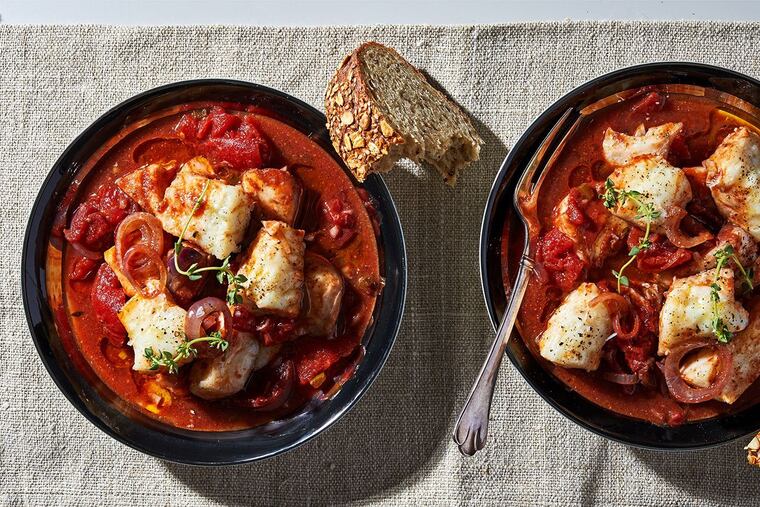Flaky white fish meets spicy red sauce in this 20-minute Portuguese-inspired dinner
Jalapeño is responsible for the kick, and, as home cooks we have learned, that type of pepper is mighty fickle about how much heat it will impart.

White fish and red sauce: Mediterranean-inspired cookbooks are filled with recipes that build on that classic combo, and for good reason. The sauce is typically light, and some of the best and easiest pairings start with canned tomatoes. Often tinned with citric acid, those tomatoes may work the same flavor-affinity magic as when mild, flaky fish is matched with a sancerre or vinho verde.
This dish is said to be in the style of the whole fish baked in a spicy red sauce and served at seaside restaurants in Portugal, except here we’re using skinned fillets to speed the process; this is ready in 20 minutes. Jalapeño is responsible for the kick, and, as home cooks have learned, that type of pepper is mighty fickle about how much heat it will impart.
A recent exchange with a reader on that subject led me to an online guide that seems to have merit. If it’s true that jalapeños get hotter as they get older (if only that were true for the rest of us), and that smooth skin is the sign of a young jalapeño, then look for the ones that are slightly darker green and look a little worse for wear, with tiny “stretch” or stress lines that run vertically from the tip end. I tested this recipe with peppers new and aged, and found the telltale signs of older jalapeños to be true. Then again, if a possible 8,000 Scoville units doesn’t scare you, taste before you toss the green bits in.
A little wine is called for here, but red wine vinegar or juices from the tomatoes can be used instead. Serve with crusty bread, for mopping.
Portuguese-Style Fish
Serves 3
12 ounces skinned cod fillets (may substitute other white-fleshed fish fillets, such as sea bass or flounder)
About 6 red pearl onions
1 medium jalapeño pepper
2 medium cloves garlic
One 14-ounce can no-salt-added whole tomatoes
1 tablespoon extra-virgin olive oil, plus more for drizzling
1/3 cup dry red wine (optional; may substitute juices from the tomatoes or 3 tablespoons red wine vinegar)
A few stems fresh thyme, plus more fresh leaves for garnish (may substitute 1 teaspoon dried oregano)
Sea salt
Freshly ground black pepper
Flaky salt, for garnish
1. Preheat the oven to 375 degrees. Defrost the fish and pat dry, as needed.
2. Trim and peel the onions; cut each one into thin slices. Stem and seed the jalapeño, then mince. Mince the garlic; combining the vegetables on the cutting board as you cut them is OK. Cut each of the tomatoes into 6 chunks.
3. Heat 2 teaspoons of the oil in an ovenproof nonstick skillet until shimmering over medium heat. Stir in the onions; cook for about 8 minutes, until mostly translucent. Stir in the garlic and jalapeño; cook for 1 minute, then add the tomatoes and their juices, the wine, and thyme. Cover and reduce the heat to medium-low; cook for 10 minutes, stirring a few times, then uncover and cook for 5 minutes more. Taste, and season with salt and pepper as needed.
4. Pat dry the fish fillets if you haven’t already. Coat them on both sides with the remaining teaspoon of oil, then season generously with salt and pepper. Place them, skin sides down, on top of the sauce in the pan, then transfer to the oven. Roast (middle rack) for 10 minutes, or just until the fish is slightly firmer and more opaque (a brighter shade of white, which is why it’s better to place them in the pan skin sides down, so you can better tell how done they are).
5. Discard the thyme stems. Drizzle with oil, scatter fresh thyme leaves on top, and serve hot.
— Adapted from “Dinner in Minutes: Memorable Meals in Minutes for Busy Cooks” by Linda Gassenheimer (Houghton Mifflin, 1995 edition).
Per serving: Calories: 200; Total Fat: 5 g; Saturated Fat: 1 g; Cholesterol: 145 mg; Sodium: 170 mg; Carbohydrates: 7 g; Dietary Fiber: 2 g; Sugars: 3 g; Protein: 22 g.